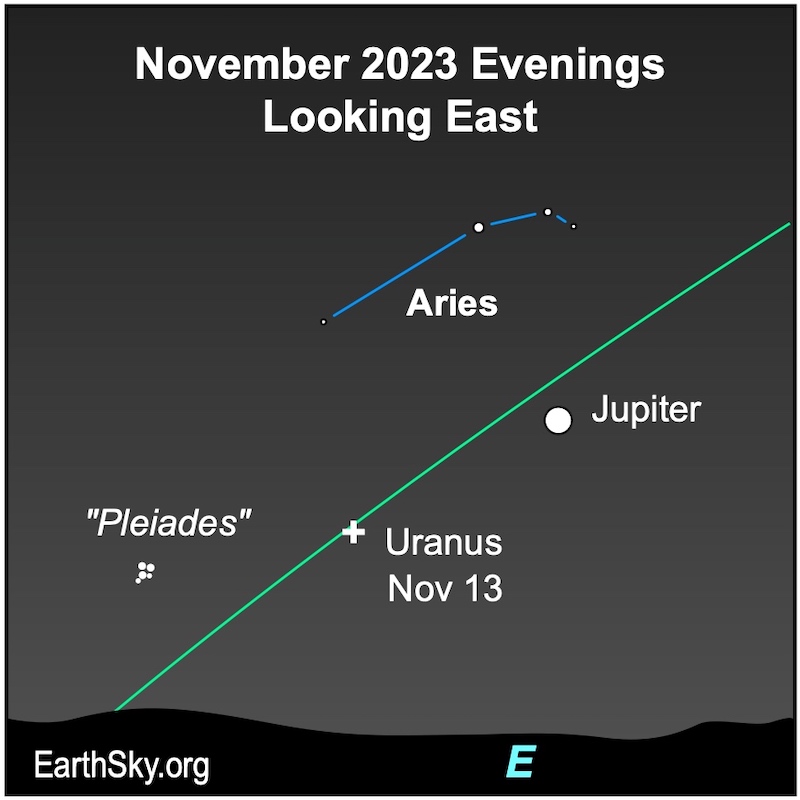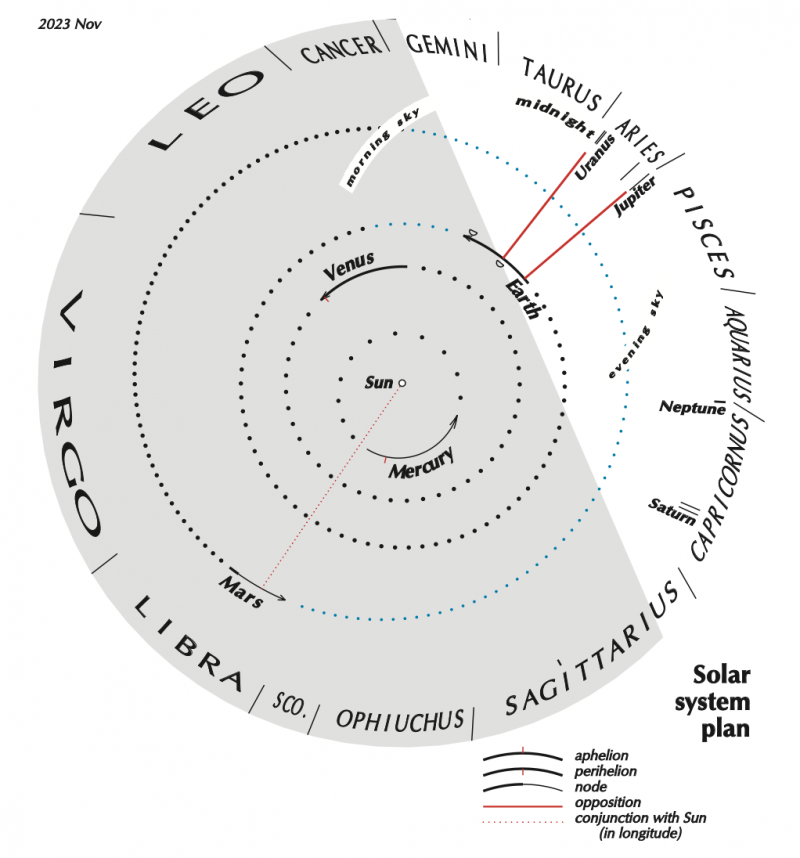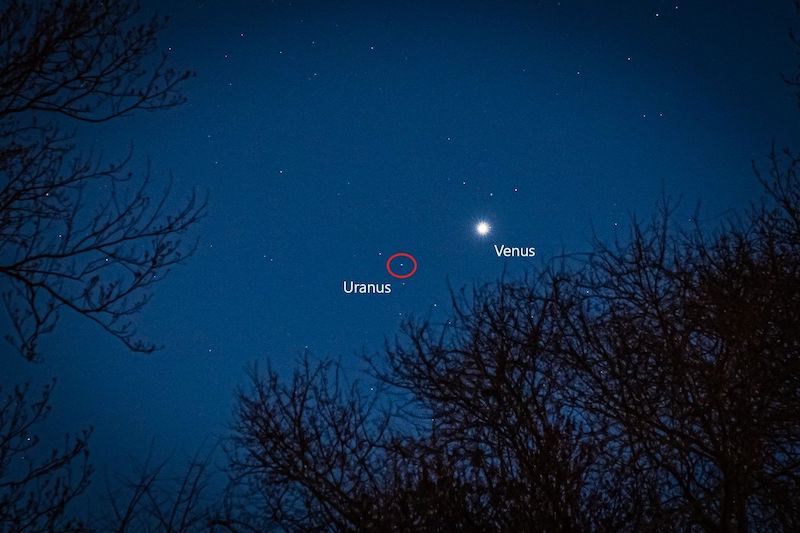
Our planet Earth will swing between the sun and the 7th planet – Uranus – on November 13, 2023. That means we’re now smack in the middle of the best time of year to see this outer planet. Have you ever spotted Uranus? It’s theoretically possible to see with the eye alone. But, in practice, Uranus is tough to locate without optical aid. Still, it’s easier with Uranus opposite the sun. It’s rising in the east as the sun sets in the west, highest in the sky at midnight.
The 2024 lunar calendars are here! Best Christmas gifts in the universe! Check ’em out here.
Uranus at opposition
When and where to watch in 2023: Uranus is theoretically visible to the unaided eye – assuming you have good eyesight – and you are under a dark sky. The planet is easily visible in good binoculars or a telescope. By the time of its November 13 opposition, Uranus is rising in the east at sunset and is visible all night. It’ll remain in the evening sky through April of 2024.
Opposition for Uranus will fall at 17 UTC (11 a.m. CDT) on November 13, 2023.
Brightness at opposition: The 7th planet shines at its brightest for 2023, at magnitude +5.6, and will have a diameter of 3.7 arcseconds.
Distance from Earth: Uranus is at its least distance from Earth for 2023, 156 light-minutes or 18.6 AU from Earth.
Constellation at opposition: Uranus is in front of the constellation Aries the Ram.
Through at telescope: Uranus appears as a tiny, greenish disk 3.7 arcseconds across. Look for up to four moons of Uranus as well.
Note: Uranus reaches a yearly maximum in brightness at or near opposition. From mid-October to mid-December, Uranus will be at its brightest, shining at +5.6 magnitude. So it should be possible to glimpse with the unaided eye, if conditions are optimum.
Quick facts about oppositions
Opposition marks the middle of the best time of year to see an outer planet.
Think of us on Earth, sweeping between the sun and Uranus in our smaller, faster orbit. Around the same time as Uranus reaches opposition, it is also making its closest approach to Earth.

For precise sun and Uranus rising times at your location:
Old Farmer’s Almanac (U.S. and Canada)
timeanddate.com (worldwide).
Stellarium (online planetarium program)
In-the-sky information and finder chart from your location
How often is Uranus at opposition?
Uranus is the seventh planet from our sun. A year on Uranus is 84.4 Earth-years long. Because Uranus’s orbit around the sun is so gigantic, and because Earth whips around the sun so quickly in comparison, Uranus’s opposition date falls about four days later each year.
2022 Uranus opposition – November 9
2023 Uranus opposition – November 13
2024 Uranus opposition – November 16
2025 Uranus opposition – November 21
Uranus events in 2023
January 22, 2023: Uranus ends retrograde motion
May 9, 2023: Uranus at solar conjunction
August 28, 2023: Uranus begins retrograde motion
November 13, 2023: Uranus at opposition

View from above the solar system, November 2023

Earth and Uranus
Our planet Earth swings between the sun and Uranus on November 13, 2023, placing us squarely in the middle of the best time of year to see this outer planet. Why? Because in November 2023, Uranus is opposite the sun in our sky. It rises in the east as the sun sets in the west. November 13, 2023, is when Uranus reaches its yearly opposition.
Because Uranus is opposite the sun in November 2023, it climbs highest for the night at midnight (midway between sunset and sunrise). So, Uranus stays out all night long. Also, around the time of opposition, Earth’s motion brings Uranus closest to Earth for 2023. The planet shines at its brightest in our sky. How bright is that? Not very bright.
The fact is, even at its brightest, Uranus is still quite faint. It’s barely perceptible as a dim speck of light to the unaided eye, even under dark skies. At a magnitude +5.6, Uranus shines no more brilliantly than the sky’s faintest visible stars. Given a dark sky free of light pollution, you might see Uranus with the eye alone. But you’ll need to have a good finder chart to know right where to look for this distant world in front of the rather faint constellation Aries.
Distance to Uranus
At its closest point to Earth, Uranus is still twice as far away from us as its next-door neighbor, Saturn. At opposition, Uranus will be just shy of 19 astronomical units (AU) away from Earth and 20 AU from the sun. (One astronomical unit equals the average distance of Earth from the sun). Visit Heavens-Above to find out the present distance of Uranus and the other solar system planets.
Other Uranus observing opportunities
While opposition is mathematically the best time to view Uranus due to its nearness and brightness, another great opportunity is when the dim planet is near a brighter, closer planet, or near the moon. For example, when Venus or Mars passes close to distant Uranus as seen from our point of view, we get an easy guidepost to point us to the gas giant.

Also, in 2023, Uranus is close to the moon on the overnight of November 25-26, making it easier to find; but Uranus may be washed out by the almost full moon.
Bottom line: Uranus reaches opposition on November 13, 2023. At this time, it’s brightest for the year and visible to the eye under optimum observing conditions. Here’s how to see it.
Read more: Seasons of Uranus, a sideways world with strange seasons
Read more: Uranus discovered by accident in 1781
The post Uranus at opposition on November 13, 2023 first appeared on EarthSky.
0 Commentaires